Get to know them. They’re changing the way we live.
November 2019
1. First of all, tell me—what is a
Forest Bather?
“The person leading the walk is the guide. The forest is the therapist.”
—Jeanne Christie
By Laurie Gallardo
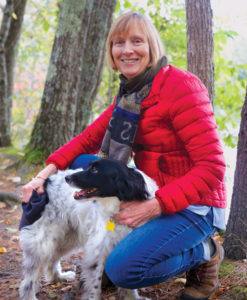 As a young sports reporter working for The Ellsworth American in the late 1970s, Jeanne Christie never imagined she’d get lost in the forest—and love it.
As a young sports reporter working for The Ellsworth American in the late 1970s, Jeanne Christie never imagined she’d get lost in the forest—and love it.
“I moved to Maine during my second year at Indiana University Bloomington,” she says. “I came back to spend the summer with my grandmother. I’d planned to return to school in the fall, but she was diagnosed with terminal cancer.”
“When I got the job with The Ellsworth American, I had to cover the Ellsworth High School boys basketball, which was the premier event of the winter season,” she says. “I didn’t know anything about sports when I took it.” In time, she became the weekly sports editor and chief photographer.
Fast forward nearly 40 years. Christie has become an award-winning wetland preservationist—and certified forest therapy guide—with assignments from the United States Environmental Protection Agency to the U.S. Department of Agriculture to the Association of State Wetland Managers, where she worked as executive director for nearly two decades.
How do you switch from sports to sensitively covering nature? “I asked my editor what I should focus on. He said environmental journalism.” So she transferred to the University of Maine at Presque Isle and graduated with a degree in environmental science and political science.
Christie landed a job in 1985 as a program and planning analyst at the Wisconsin Department of Natural Resources. After three years, she got married, moved to Washington D.C., and began working for the EPA. The laws granting wetlands protection were minimal, but soon enough, things began to evolve. Christie was at the forefront.
“The whole national arena changed. Suddenly, there were all kinds of new regulations that were embedded in the law to protect wetlands.” Her career kicked off.
Christie became a driving force in the development of state and national strategies for wetland protection, conservation, and restoration, including state and federal implementation of the Clean Water Act, particularly Section 404, which deals with dredge and fill permits. “Our success was possible only because of the contributions of many individuals, agencies, and organizations working together,” she says. “Changing environmental programs and policies is a big lift and always a group effort. That’s what makes natural resources so fascinating—you can never rest on your laurels.”
Though Christie continues to work as a consultant at Christie Consulting Services, just over a year ago she started Connect to Wilderness, where she takes individuals on nature walks as a certified forest therapy guide.
“We have a relationship with nature that goes back millennia, but there’s been a separation,” Christie says. “A couple of years ago, during my daily run in the woods with my dog, I stopped and heard what sounded like a shout—with no sound—making me pause and look at the forest around me. All of a sudden, I was just heavily falling into the natural world surrounding me. I couldn’t figure out the context. Then I saw a newspaper article on guided forest therapy training.”
As a guide, Christie does just that—leads those who are searching for oneness with nature.
“The guide is not a teacher or a leader, and I certainly don’t know how to be a therapist,” she says. “The person leading the walk is the guide, and the forest is the therapist. It’s between you and the natural world. It’s not my job to deliver the experience—I just provide the invitation.”
2. Dreamscaper
Painting our city’s soul.
By Colin W. Sargent
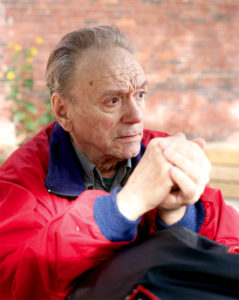 If you’re looking for the essential Portland artist, one who walks the walk like the artists in La Bohème,
If you’re looking for the essential Portland artist, one who walks the walk like the artists in La Bohème,
Michael Waterman is that guy. He’s an urban legend. He paints this city like it’s his personal mythology. When Natalie Merchant, the Grammy-winning singer/composer (“Carnival,” “Wonder,” and lead singer for 10,000 Maniacs) was rehearsing in Maine, she fell in love with his work. She snapped up his Woman With a Fish for $2,400 from the legendary Aucocisco Gallery. Then another. She, like all of us, was hooked. She wanted to meet Michael Waterman. Yeah, right. Waterman said no to the meeting. Why give up valuable painting time? He’s a painter, not a public relations dude. Just try and get an audience. Well, okay.
Where is your studio right now?
I paint in my apartment on the third floor of Forest Avenue and Congress Street. It’s [barely] across the street from where I used to paint at the top of the Schwartz Building.
What can you see from your windows?
I see the Portland Museum of Art facade and some rooftops.
Has this new view worked its way into one of your paintings?
No. Not yet.
Does Natalie Merchant still keep up with you?
I don’t know, but my gallery director Tom O’Donovan says she’s bought a few more things.
So she’s still keeping up with you!
Tom and I have an agreement. He doesn’t have to tell me what’s going on at the gallery, and I don’t have to tell him what I’m doing in the studio.
What are you doing in your studio?
I’m painting 90 percent terrible and 10 percent acceptable.
Tell me about the terrible.
The terrible look great in my head. But they don’t make it to my hand.
How old are you? I’m 65.
I’m 32.
3. Brain Storm
“I want to inspire young girls like myself.”—Amara Ifeji
By Rebecca Garibaldi
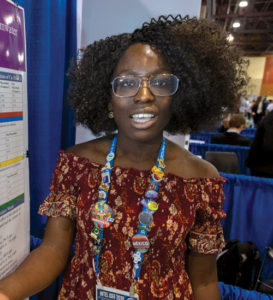 Amara Ifeji, 17, has shown through consistent hard work and passion you can accomplish quite a bit. From her victory at the International Science and Engineering Fair (ISEF), to multiple awards for her research projects on methods of water purification in the STEM (Science, Technology, Engineering, Mathematics) 4-year academy program at Bangor High School, to starting a diversity union within her school, Amara is just beginning to make the world a better place.
Amara Ifeji, 17, has shown through consistent hard work and passion you can accomplish quite a bit. From her victory at the International Science and Engineering Fair (ISEF), to multiple awards for her research projects on methods of water purification in the STEM (Science, Technology, Engineering, Mathematics) 4-year academy program at Bangor High School, to starting a diversity union within her school, Amara is just beginning to make the world a better place.
What sparked this motivation at such a young age? Her family. In 1996 her grandparents immigrated from Nigeria to Maryland. Her grandfather worked as a security guard and her grandmother as a CNA. “They held these minimum-paying jobs for over 20 years while trying to support their household, which consisted of nearly fifteen people at one point. They took care of my cousins and me while our parents went to school. I want to show my grandparents that everything they went through was not in vain. I want to make them proud.”
Amara is paying it forward to those most in need. “Diversification and tackling current environmental issues are important to me. I want to inspire young girls like myself to make a difference by educating and motivating them.” Upon moving to Bangor in 2011 for her mother’s pharmaceutical career, Amara began to realize the limited diversity in both the town and schools. “I started a minority student union at Bangor High School. This is not just a safe haven for minorities but also for Caucasians. I created this union for all to become more educated on racial diversity. I want to create a safer space.”
Her award-winning project in the category of plant sciences at the 2019 ISEF is on water purification through the use of arbuscular mycorrhizal fungi. “[According to the World Health Organization] there are 785 million people worldwide who don’t have access to clean drinking water, and that’s not just third-world countries. Bangor High School had three water fountains shut down while I was attending because of contaminated drinking water.” Amara’s goal is for all to have access to clean and safe drinking water. “I hope for the preservation of the environment so future generations can enjoy and experience the same things I did growing up, such as seeing Cadillac Mountain for the first time.”
So what’s next? “I’m currently in the process of applying to colleges.” At the top of her list is Brown University. “I plan on majoring in chemical or environmental engineering with a minor or double major in environmental sustainability or equity. I want to include social justice, racial groups, and different ethnicities in my education as well.”
4. Thinkin’ Lincoln
“My brain remembers things that aren’t important.” —Lincoln Peirce
By Brian Daly
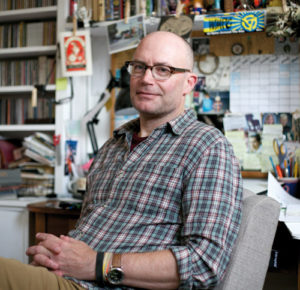 When Lincoln Peirce (pronounced “purse”) lived in Brooklyn from 1985 to 1992, he listened to old-timey country music on WKCR, the Columbia University radio station. One day he heard a song he liked called “Don’t Fix Up the Doghouse,” but, to his disappointment, he didn’t hear who sang it. Ten years later—but still before the Internet made solving this kind of mystery easy—he heard that voice a second time singing another song, and he had his answer. George McCormick.
When Lincoln Peirce (pronounced “purse”) lived in Brooklyn from 1985 to 1992, he listened to old-timey country music on WKCR, the Columbia University radio station. One day he heard a song he liked called “Don’t Fix Up the Doghouse,” but, to his disappointment, he didn’t hear who sang it. Ten years later—but still before the Internet made solving this kind of mystery easy—he heard that voice a second time singing another song, and he had his answer. George McCormick.
Who?
He’s a singer familiar to listeners of “South By Southwest,” a radio program devoted to honky-tonk, western swing, and straight-ahead country music recorded prior to 1975. Lincoln has hosted the show for twenty years every Monday morning on WMPG 90.9, the University of Southern Maine’s community radio station.
Wait. Did he recognize the voice after ten years?
“I have a good memory for music,” says Lincoln, 56. “My brain remembers things that aren’t important.”
But this Colby College grad remembers things that are important, too, including what it was like to be a kid growing up in Durham, New Hampshire. Those memories serve him well in his career as the creator of Big Nate, the popular comic strip about the misadventures of Nate Wright, a sixth-grader who’s a record-setter—for getting the most detentions. “People ask me all the time how I get my ideas, and my answer is boring: I sit down and think them up.”
Lincoln also drew the eight popular Big Nate books, aimed at middle-grade readers. These hybrids of text and pictures held down a top ten slot on the New York Times bestseller list for over 140 weeks. Sales of the series plus compilations have topped 18 million books.
Now, Lincoln is working on book two of a three-book series featuring the funny adventures of Max and the Midknights. Max is an apprentice troubadour in medieval times who wants to grow up to be a knight. These books are hybrids, too. As always, Lincoln does the design and layout by hand. When his editor at Crown Books for Young Readers calls for changes, Lincoln makes them the old-fashioned way. “I enjoy trying to fit the words and pictures together. It appeals to the puzzle solver in me.”
With the thousand-plus pictures he has to draw for each Max and the Midknights book—not to mention the 25,000 words he has to write—Lincoln is a prime candidate for a digital device that would allow him to alter the size and placement of pictures and text simultaneously. He hasn’t found one, though, so he continues to work the old-fashioned way. Actually, he hasn’t looked very hard. “My system is inefficient,” he says, “but I work on deadline, and I worry about the time spent learning how to use technology. It isn’t at all intuitive for me. I haven’t been able to make the jump. If I did, though, I wouldn’t have to stay up until one in the morning.”
The room where he does this painstaking work is on the first floor of the colonial home he shares with his wife Jessica Gandolf, an acclaimed painter, in the Deering Highlands neighborhood of Portland. It’s filled with about 1,200 CDs shelved alphabetically, sports memorabilia, and pictures of their son Elias and daughter Dana. Tucked behind some books over in the corner is the blue ribbon Lincoln won for his apple pie at the Cumberland Fair in 2004. It was the only time he ever entered.
“I retired undefeated.”
5. Go Ahead & Jump
“I know I’ll be ready for some big jumps in the near future.”—Kate Hall
By Sofia Voltin
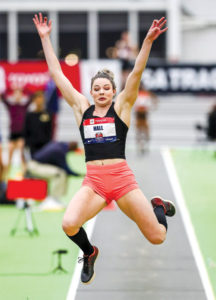 Kate Hall is unstoppable. At ten, she enjoyed soccer, basketball, and track—on target for an athletic career—when she was diagnosed with Type 1 diabetes. “I was forced to take control of it.” She insisted on giving herself that first insulin shot. Now 22, Hall still leaps over any obstacles in her way. “I broke the [39-year] national high school long-jump record and American Junior record with a jump of 22 feet, five inches. This qualified me for the 2016 Olympic Trials”—where she placed tenth. According to the IAAF (International Association of Athletics Federations), Hall currently ranks No. 6 in the U.S. outdoor long jump.
Kate Hall is unstoppable. At ten, she enjoyed soccer, basketball, and track—on target for an athletic career—when she was diagnosed with Type 1 diabetes. “I was forced to take control of it.” She insisted on giving herself that first insulin shot. Now 22, Hall still leaps over any obstacles in her way. “I broke the [39-year] national high school long-jump record and American Junior record with a jump of 22 feet, five inches. This qualified me for the 2016 Olympic Trials”—where she placed tenth. According to the IAAF (International Association of Athletics Federations), Hall currently ranks No. 6 in the U.S. outdoor long jump.
She won All-America honors 8 times in high school, along with over 30 state and New England championships. “I home-schooled and planned my days to my benefit. This flexibility was a game-changer in my career because I could train any time. It prepared me for college as well.”
Hall studied exercise science during her one year at Iowa State and then two years at University of Georgia. At the end of her junior year, her gaze turned to the 2019 World Championships and the 2020 Olympics in Tokyo, but her jumps had not improved within the college system. She returned to Maine to train with her high-school coach. “Training is far more individualized with Chris Pribish. In college programs, I didn’t always feel fully recovered between workouts. They emphasized a lot of heavy lifting, which isn’t best for me.”
“With diabetes, people sometimes need more recovery,” Pribish says. “We are flexible and adjust workouts if sugar levels are too high or low. Our scientific approach tends to buck some of the common trends used in schools.”
In February, Hall wrapped up her first season as a professional athlete with a national title. “A lot of my competition is surprised I’m from Maine. It isn’t a typical place for a track athlete to train because of the cold.” At the Toyota USATF Indoor Championships in New York, she won the long jump with a leap of 21 feet, 41/4 inches and came in second in the 60-meter dash. Her winnings totaled $10,000.
But a crushing summer waited ahead. “I didn’t make the 2019 World Championships.” She placed 10th in the qualifying meet with a best jump of 21 feet, 6 inches—missing the final round by one and a half inches. “I was in the best shape of my life. My approach was a little off, so I didn’t hit the takeoff board. If I had, I’d have easily qualified for the World Championships. My goal for over a year was to make it. It was very hard to come up short. But I learned from this. I wasn’t able to pull it together that day, but my body was in the best condition it’s ever been. I know I’ll be ready for some big jumps in the near future. I’m taking this mindset and preparing for the 2020 Olympic Trials.” She’ll be competing on June 19 and 20, 2020 at the University of Oregon. “I’ve jumped there several times, and I’m excited to go back.”
Hall currently lives in Gray. She works as an assistant coach at St. Joseph’s College and trains with Pribish at Momentum Performance & Wellness Center in South Portland. “She works extremely hard,” Pribish says. “She ignores outside distractions and focuses on achieving her goals. She holds herself to high standards and refuses to fail. Kate will continue to succeed on and off the track. She’ll win more titles and make Olympic and World teams for years to come.”
6 & 7. The Power of Love
“…Yes might mean no. The brain is unbelievable.”—Annemarie Albiston
By Laurie Gallardo
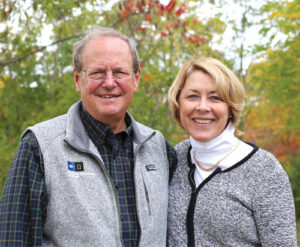 One day you wake up and no one can understand you. In 2005, Annemarie Albiston’s father suffered a massive stroke, leaving him diagnosed with aphasia. “It’s a loss of language—not intellect,” Annemarie says. “It robs you of your communication. “It can affect not only your verbal speech but your ability to read and write. My father lost all three. He knew what he wanted to say but couldn’t get it out. Sometimes aphasia can affect comprehension, too, so yes might mean no. The brain is unbelievable.”
One day you wake up and no one can understand you. In 2005, Annemarie Albiston’s father suffered a massive stroke, leaving him diagnosed with aphasia. “It’s a loss of language—not intellect,” Annemarie says. “It robs you of your communication. “It can affect not only your verbal speech but your ability to read and write. My father lost all three. He knew what he wanted to say but couldn’t get it out. Sometimes aphasia can affect comprehension, too, so yes might mean no. The brain is unbelievable.”
Beginnings
Annemarie and her husband, Bruce Albiston, opened Aphasia Center of Maine in 2012 and Adaptive Outdoor Education Center in 2015. The Andre R. Hemond Aphasia Retreat—named in honor of Annemarie’s father—is held every fall. It’s a social gathering to support people living with aphasia; both those diagnosed and their loved ones.
“During one of our first retreats,” Annemarie says, “I had breakfast with a couple. The wife had aphasia and spoke zero words. Her husband stepped out for coffee, so I sat and chatted with her. ‘Do you have children?’ She nodded. ‘How many?’ She held up her fingers. When her husband returned, I casually mentioned she told me they had children. He was shocked. ‘Nobody ever has a conversation with her. How did you do that?’ I’d learned the secret from my father. You love them for the people they are.”
Aphasia Connections hosts cafe get-togethers and fun group activities. “Weekend Craftcations are for making crafts.” Annemarie’s sincere, encouraging smile conveys a warming candor. “But some people don’t give a hoot about doing that. They just want to be together. The whole point is to give people the best quality of life. Everyone we meet has the same story—friends and family desert them. They think aphasia means they’re not the same person anymore, but they are. There’s life after stroke.”
“To do something inclusive for all ages and disabilities, we built the lodge at Sugarloaf,” Bruce says. Enter the Adaptive Outdoor Education Center in Carrabassett Valley. Activities range from rock climbing to skiing. “The folks we work with have had so much therapy in their lives. Instead, we give them experiences they’re going to remember.” Bruce says. “We don’t just go for a sail—we teach people how to sail.”
The Albistons are adding more housing to the lodge. Next stop is an event space in Greater Portland. “We’re trying to grow the number of people we serve,” Bruce says.
“Our youngest [attendee] had a stroke when she was 9. She’s 15 now,” Annemarie says. “We met Emma a few months after her stroke. The first time she came to our retreat, her father had tears in his eyes watching his little girl relax and have fun. Now they’re a huge part of our community. The people here are my heart and soul. Sometimes it’s like being with my dad again. He passed eight and a half years ago. These folks are our family.”
8. From the Maine Woods to the D.C. Swamp
“This is my last hope to really bring the integrity back into our office.” —Tricia Newbold to the House Oversight Committee
By Colin W. Sargent
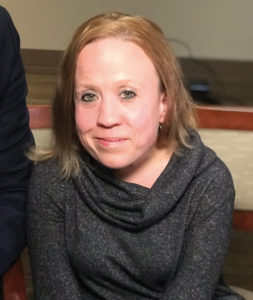 The first miracle is, how does a girl from Madawaska rise to become a senior security specialist in the Executive Office of the President? Young women and men across the state will appreciate knowing how to chart those stars! The next miracle is, when your moment of truth comes, will you be equal to it?
The first miracle is, how does a girl from Madawaska rise to become a senior security specialist in the Executive Office of the President? Young women and men across the state will appreciate knowing how to chart those stars! The next miracle is, when your moment of truth comes, will you be equal to it?
So often a person from Maine is called upon to be the conscience of our country. On 23 March 2019, Tricia P. Newbold, “at great personal risk,” came before the House Committee on Oversight and Reform “to expose grave and continuing failures of the White House security clearance system,” according to a memorandum from the late Elijah Cummings (D-MD), chair of the committee. Twenty-five Trump Administration officials were first denied security clearances; Newbold was one of the specialists who issued the security denials. But a wand was waved, and suddenly they received overrides. According to the Washington Post, Newbold began to keep a list of Trump staffers receiving security overrides “in 2018.”
“In an administration in which too many have chosen the path of least resistance—silence—Tricia Newbold decided to put principle first and speak out,” says Ned Price, former National Security Council spokesman under President Obama, who has worked with Newbold.
“As a native of Madawaska, Tricia’s integrity and willingness to stand up for what she believes is right are a testament to her Aroostook County values,” Senator Susan Collins says. “Whistleblowers have played a vital role over the decades in bringing to the attention of Congress wrongdoing, fraud, and abuse. By speaking up, Tricia hopes to ensure that Americans can have confidence that decisions to grant, deny, or revoke security clearances are based solely on established guidelines.”
Since her appearance, Newbold has disappeared from the public eye.
Global Intel reports Newbold “earns around $120,000 a year and began with the government earning less than $30,000.” She started her career with the Clinton Administration in 2000, then continued during the George W. Bush Administration, the Barack Obama Administration, and now the Trump Administration. She’s 40 and lives in Severn, Maryland. Her parents still live in Madawaska.
“She was a very smart and determined student who did not want special privileges or special treatment. Her friends were helpful, lifting her up when necessary, so she could do ‘things’ by herself and not have someone do it for her,” says Gisèle Dionne, Superintendent of Schools, Madawaska. “I taught the physical sciences. I’m thrilled that you’re naming Tricia. She’s very deserving.”
9. Meet the First Woman Ever to Vote in Maine
Augusta Merrill Barstow Hunt
By Anne B. Gass
“Learning about the life and devotion to freedom and equality that Augusta had has filled me with a sort of pride I have no right to, and inspiration to keep her work and dreams alive. Even, especially, in these troubled times.” —Helen Hunt
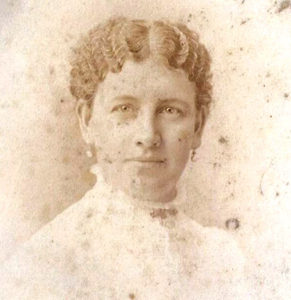 “A great humanitarian”—that’s how the Portland Sunday Telegram described Augusta Hunt on her 90th birthday. Throughout her long life, she championed many causes, using her wealth and privilege to improve the lives of those less fortunate.
“A great humanitarian”—that’s how the Portland Sunday Telegram described Augusta Hunt on her 90th birthday. Throughout her long life, she championed many causes, using her wealth and privilege to improve the lives of those less fortunate.
Augusta Merrill Barstow was born in Portland on 6 June 1842. At the age of 21, she married George S. Hunt, a prosperous merchant with West Indies shipping interests, including sugar importing. They set up housekeeping in the stately brick townhouse at 165 State Street (now the home of Portland Monthly Magazine) and raised two sons.
With a lively mind, a keen interest in history, and her husband’s support, Hunt soon found ways to be active in the community. She had a particular interest in improving the lives of women and children. Once, she heard a story of a husband who sent his young children to live with relatives in Canada. His wife objected but had no legal way to stop him. Hunt went to work, and in 1895, the Maine legislature passed an equal guardianship law.
In 1876 Hunt helped found the Maine branch of the Woman’s Christian Temperance Union (WCTU) and served for many years as its president. This sparked her interest in voting rights for women, which the WCTU saw as vital for protecting the home and children. For decades, Hunt and others campaigned for full voting rights through the Maine legislature. When the all-male legislature turned them down (repeatedly), they tried for the right to vote in municipal elections or simply for the U.S. President. All of these efforts failed.
Oil & Water
“I’ve always been struck by the great success of both my great-grandparents. The George S. Hunt & Company was composed of 21 ships and two sugar refining companies. The ships sailed to Cuba and returned with sugar cane which was refined and used in the distilling of rum.
Augusta, on the other hand, was a leader in the local Christian Temperance Union, advocating sobriety. One can only imagine the heated conversations between them! George only lived to the age of 67. Augusta was left financially well-off. She had the time and means to pursue her other interest—achieving equal rights for women to vote. She was quite a force and lived into her nineties—also an achievement in those times.” —George S. Hunt III (great-grandson, age 93)
Maine Woman Suffrage Association
In 1916, Maine suffragists finally had sufficient votes in the legislature to send the suffrage question to voters in a referendum. Now 75 and retired, Hunt agreed to serve as interim president of the MWSA during a short-term leadership crisis. In October 1916, she hosted MWSA’s annual meeting at her State Street home to choose a new president and decide whether to pursue the referendum.
Opposing the idea was none other than Carrie Chapman Catt, the president of the National American Woman Suffrage Association (NAWSA). This was odd because, for decades, NAWSA had been all about state campaigns. But Maine wasn’t ready, she counseled. MWSA had only $160 in its bank account, a tiny fraction of the war chest it would need—especially because it lacked experienced suffrage organizers. A campaign would require outside help. Catt wanted to use NAWSA’s scarce resources to support campaigns in states where success was more likely.
Hunt served coffee rather than the customary tea, and perhaps the extra infusion of caffeine emboldened the almost 100 women gathered there. Insisting that the “good old state of Maine” wouldn’t let them down, they voted to pursue a suffrage referendum.
While no longer its president, Hunt worked hard on MWSA’s campaign. She went door-to-door collecting signatures from women on a voting rights petition. She found office space for the Suffrage Referendum League of Maine at 662 Congress Street, in the storefront of the Queen Anne style building her husband built in 1886.
Working for rights denied by society requires sacrifice, courage, and the ability to take the long view. Hunt demonstrated these in abundance throughout her career. So, when the referendum met with resounding defeat, she just looked ahead to the next campaign.
The 19th Amendment that gave most women the right to vote was ratified in August of 1920. In recognition of her many contributions, Hunt was given the distinction of being the first woman to cast a ballot. “It was indeed fitting that…when woman suffrage was at last granted the first woman’s ballot to be passed was that of Augusta Hunt,” said Maude Wood Park, Ex-President, National League of Women Voters, to the Portland Sunday Telegram on 5 June 1932, in “Mrs. George S. Hunt About to Pass her 90th Milestone.”
For 50 years, Augusta Hunt supported or led every movement in Maine to improve the lives of women and children. Highlights include equal guardianship, free kindergartens and day nurseries, Portland’s first-ever police matron, a women’s reformatory, a rest home for aging women, and, of course, voting rights.
This Spring, 2020, a roadside marker that recognizes Hunt’s suffrage work, donated by the William G. Pomeroy Foundation, will be installed outside 165 State Street.
As her 90th news article concluded, “Her name will live long and her work will live always.”
Book Worm
Augusta Hunt had two hobbies—bridge and Charles Dickens. She devoted a corner of her suite at the Eastland to prints of Dickens characters and held a Dickens Club meeting twice a month from November through May. One morning while Dickens was in Portland, George Hunt spotted the author leaving the Preble House. When he started to walk up Cumberland Avenue, George hurried home to tell his wife the news that Dickens was likely to walk past the Hunt mansion. Before long, Augusta spotted him passing their home. “I would have liked to shake his hand and tell him what his books meant to me,” Augusta said, “but I recalled what he had said about ladies gushing, and I made up my mind I was not going to gush.”
—Anne B. Gass is the author of Voting Down the Rose: Florence Brooks Whitehouse and Maine’s Fight for Woman Suffrage, a book about her great-grandmother. She serves on the steering committee for the Maine Suffrage Centennial Collaborative and speaks frequently on suffrage history.
10. Dream Leader
“That’s not how you do it, but that’s how I do it.” —Gabriel Frey
By Diane Hudson
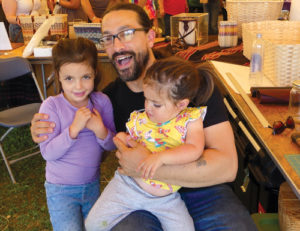 “Isn’t there an easier way?” It’s a question Gabriel Frey, twelfth generation Passamaquoddy artist, is frequently asked. “They are well-meaning, but there are no shortcuts to doing what I do.
“Isn’t there an easier way?” It’s a question Gabriel Frey, twelfth generation Passamaquoddy artist, is frequently asked. “They are well-meaning, but there are no shortcuts to doing what I do.
“I use black ash for my baskets. I cut down a basket-quality tree—straight, with little-to-no branches—and carry the log on my shoulder out of the woods. To get the raw material, I pound the log to fracture the fiber within the growth ring. I have to strike every square inch of the tree, all by hand. Once they’ve been removed from the tree, I further refine the individual growth rings by splitting and gauging them to the desired thickness and width.
“What I do has been done for thousands of years.” Black ash is so closely tied to Frey’s culture, it features centrally in the creation story of the Wabanaki people. “Glooskap is a mythical figure, kind of a trickster guy. Legend has it he shot his arrows into the heart of the ash tree. When it split open, our people were created.”
Frey’s talents stretch beyond basketry. “I’ve done a lot of oil paintings and a few charcoal sketches. I’m inspired to use my artistic voice to raise the profile of Maine’s indigenous population, which has been marginalized for so long. I hope to add to our story and, in doing so, enrich Maine culture.”
In early 2019, Frey, 39, won the prestigious United States Artists Award, a $50,000 unrestricted fellowship. He’s come a long way from when he made his first basket at the age of 18. “I told my mom I wanted to go and make a basket when the Maine Indian Basketmakers Alliance (MIBA) offered a workshop in our community. She was like, ‘Yeah, sure.’ When I started working, it was as if I were remembering something I’d done before—a cellular memory.”
His first creation, a traditional “potato basket,” was originally designed for farmers’ use in Penobscot county. “I was always drawn to making work-related baskets. My grandfather was a strict utilitarian. His baskets were tools and meant to be used. Very few basket makers my age were working in this tradition. They were making ‘fancy’ baskets, smaller and more decorative.
“When my grandfather developed emphysema, suddenly there was a time limit on how much I could learn. I went to live and study with him.” Frey remembers vividly the day his grandfather said, I can teach you how to make baskets, but you must learn yourself how you make baskets.
“For the longest time, I followed in my grandfather’s footsteps. Strictly utility. Then I was making a basket for a friend and decided instead of just carving the handle, I’d sand it down. It became a polished handle. You could see the sheen in the wood—so satisfying! I began putting more time into each piece. I worked on the details and finished the edges. Each little thing led to more. A couple of elders said, ‘That’s not how you do it.’ Remembering my grandfather I thought, ‘That’s not how you do it, but that’s how I do it.’
“For us, form has always followed function—the pack basket, for example. Prior to European contact in the U.S., roads were rivers and every family had a canoe. The design of the basket was flat on one side to fit your back and rounded on the other to fit into the hull of the canoe. The form is the function. The purses I make, for which I’m now well-known, are shaped like the pack basket. I’m still doing the same thing, but today, the function is different. They are wearable works of art built within the same tradition that connects people to my homeland in a physical way. This is all part of keeping the cultural history alive and maintaining awareness of what our society looked like prior to European influence.”
Thanks to the $50,000 prize, Frey expects to be able to devote more time to developing newer and more refined forms for current functions. He works another job part-time to support his family. “I also have a small integrative massage practice in the Bangor area. I’m primarily in clinical massage modalities—myofascial release, trigger point, deep tissue massage, and sports massage.” His wife, Suzanne Greenlaw, is a Maliseet doctoral candidate in ethnobiology at the University of Maine. They have two children, Musquon, 6, and Alamosit, 2. “The typical artist demands that you go down into your creative cave and come up after 3 days for food,” Frey says. “I could do that, but I’m content. The children are amazing. You choose your struggles.”
There are many spelling variations of Glooskap: Gluskabe, Gluscabi, Koluscap, Klouscap.
Know more? Share them with us at staff@portlandmonthly.com.





What an amazing collection of Mainers! Congratulations to all on the work they’re doing!